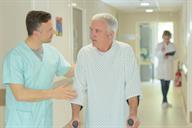Cardiac Rehabilitation
What is cardiac rehabilitation?
Cardiac rehabilitation is a treatment program that helps improve the health and well-being of people who have heart problems. Cardiac rehabilitation includes exercise training, education, and counseling to help you get stronger and return to an active lifestyle. This program can help you get better faster, lessen any future hospital stays, and improve your quality of life.
Why might I need cardiac rehabilitation?
Cardiac rehabilitation programs can help when you have or have had:
Cardiac rehabilitation programs are also used when you have had:
What are the benefits of cardiac rehabilitation?
Cardiac rehabilitation can help you:
Cardiac rehabilitation can also help you:
Get support from health experts as well as other people with similar challenges.
Learn healthy ways to manage stress.
Learn how to manage and understand your medicines.
Teach your family about your condition and how to participate in your recovery.
What is a cardiac rehabilitation team and what do they do?
The cardiac rehabilitation team works with you to make a plan based on your health and goals. Your program will be specific to you and your needs and may change as you progress. You may work with a health care team that includes:
A cardiac rehabilitation team will check your health history and do a physical exam. You may need blood tests, exercise stress tests, and other tests to make sure that you are ready to start cardiac rehabilitation.
What are the phases of cardiac rehabilitation?
A cardiac rehabilitation program is often split into phases. You move from one phase to the next.
Phase 1

This phase starts while you are still in the hospital. You may:
Phase 2

This phase begins when you go home or to another center. You will travel to a cardiac rehabilitation center or another place where rehabilitation is offered. This phase may last 12–18 weeks and is usually 2–3 days a week. During this phase:
You will slowly increase your activity level while being closely watched by a nurse or therapist.
You will have medical tests and exams to monitor your progress.
Your exercises may include strength or resistance training along with activities that cause your heart to beat faster (aerobic exercises), such as walking on a treadmill.
Your condition will determine how often and how long these sessions last.
- You may learn how to:
Cook heart-healthy meals.
Control your blood sugar, if this applies.
Stop smoking.
Manage your medicines. This may include scheduling or planning how and when to take your medicines. If you have questions about your medicines, talk with your health care provider.
Phase 3
This phase continues for the rest of your life. In this phase:
There will be less supervision.
You may continue to do cardiac rehabilitation activities or become part of a group in your community.
You may benefit from talking about your experience with other people who have similar challenges.
Follow these instructions at home:
-
You have severe chest discomfort, especially if the pain is crushing or pressure-like and spreads to your arms, back, neck, or jaw.
-
You have discomfort in the chest, neck, arm, jaw, or back (angina) that lasts for longer than 5 minutes and medicine does not help.
-
You have fast or irregular heartbeats (palpitations).
-
You have trouble breathing or shortness of breath.
-
You have sweating that is not caused by exercise.
-
You have nausea or vomiting.
-
You feel tired or weak and do not know why.
- You have any symptoms of a stroke. "BE FAST" is an easy way to remember the main warning signs of a stroke:
B - Balance. Signs are dizziness, sudden trouble walking, or loss of balance.
E - Eyes. Signs are trouble seeing or a sudden change in vision.
F - Face. Signs are sudden weakness or numbness of the face, or the face or eyelid drooping on one side.
A - Arms. Signs are weakness or numbness in an arm. This happens suddenly and usually on one side of the body.
S - Speech. Signs are sudden trouble speaking, slurred speech, or trouble understanding what people say.
T - Time. Time to call emergency services. Write down what time symptoms started.
- You have other signs of a stroke, such as:
These symptoms may be an emergency. Get help right away. Call 911.
This information is not intended to replace advice given to you by your health care provider. Make sure you discuss any questions you have with your health care provider.
 This phase starts while you are still in the hospital. You may:
This phase starts while you are still in the hospital. You may: This phase begins when you go home or to another center. You will travel to a cardiac rehabilitation center or another place where rehabilitation is offered. This phase may last 12–18 weeks and is usually 2–3 days a week. During this phase:
This phase begins when you go home or to another center. You will travel to a cardiac rehabilitation center or another place where rehabilitation is offered. This phase may last 12–18 weeks and is usually 2–3 days a week. During this phase: